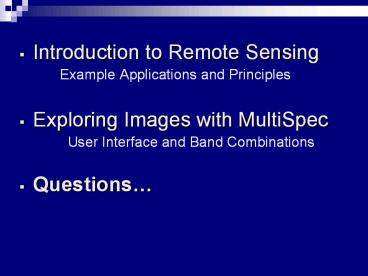Introduction%20to%20Remote%20Sensing - PowerPoint PPT Presentation
Title:
Introduction%20to%20Remote%20Sensing
Description:
Introduction to Remote Sensing – PowerPoint PPT presentation
Number of Views:88
Avg rating:3.0/5.0
Title: Introduction%20to%20Remote%20Sensing
1
- Introduction to Remote Sensing
- Example Applications and Principles
- Exploring Images with MultiSpec
- User Interface and Band Combinations
- Questions
2
Definitions
- Lillesand and Kiefer (1994) The science and
art of obtaining information acquired by a
device that is not in contact with the object - CCRS Glossary A group of techniques for
collecting image or other forms of data from
measurements made at a distance from the object,
and the processing and analysis of the data.
3
Examples of Remotely Sensed Data
- Weather
- Ocean Properties
- Physical Geography
- Major Disturbance Events / Hazards
- Cultural Features urban mapping
- Many other examples thematic info
4
(No Transcript)
5
back
6
disturbance
back
7
back
8
back
9
(No Transcript)
10
Decision
From Lillesand and Kiefer (1994)
11
Decision
From Lillesand and Kiefer (1994)
12
(No Transcript)
13
An Electromagnetic Wave
l wavelength
c velocity of light
n frequency
From Lillesand Kiefer (1994)
14
(No Transcript)
15
(No Transcript)
16
(No Transcript)
17
(No Transcript)
18
O3 absorption at 0.2 um
19
H2O absorption at 1.4, 1.6, and 1.9 um
20
CO2 absorption at 2.0 um
21
CH4 absorption at 2.2 2.5 um
22
Human eye
23
E(l)i E(l)a E(l)t Er(l)
Incident Energy
Reflected Energy
24
Atmospheric Interactions
Rayleigh Scattering
25
Types of Satellite Orbits
- Geostationary 35,790 km above the Earth
- Sun-synchronous or Polar between 700 and 800
km above the Earth
26
Satellite Orbits
http//science.nasa.gov/Realtime/jtrack/3d/JTrack3
D.html
27
(No Transcript)
28
Resolution in Remote Sensing
- Four types
- 1) Spatial the ground coverage / pixel
- 2) Spectral area and subdivision of the EM
spectrum - 3) Temporal frequency of coverage
- 4) Radiometric sensitivity to changes in
energy intensity
29
Issues of spatial temporal scale of the sensor
platform -SPATIAL- grain and extent Pixel
-TEMPORAL- Frequency of
imaging
30
(No Transcript)
31
September 30
September 15
October 15
October 30
32
Color Theory and Band Combinations
- Additive colors vs. Subtractive colors
- Natural and False color composites
- Displaying images, extracting information
33
- Additive Primaries
No single primary can be formed by mixture of
other two All other colors can be formed by
mixtures of additives
- Subtractive Primaries
Representations of color via pigments and
dyes Yellow absorbs blue, cyan absorbs red,
magenta absorbs green
34
Blue (0.45 um) Green (0.55 um) Red (0.65 um)
35
Green 2.5 x
Red x
Blue x
Blue (0.45 um) Green (0.55 um) Red (0.65 um)
36
Feb. 14, 2006 MODIS Terra, Eastern US
37
Snow Vs. Clouds
Clouds scatterat all wavelengths
Snow absorbs at gt1.4 mm
38
Snow Vs. Clouds
Clouds scatterat all wavelengths
Snow absorbs at gt1.4 mm
c
39
(No Transcript)
40
(No Transcript)
41
Natural Color 3,2,1
Color IR 4,3,2
False Color 5,4,3
42
(No Transcript)
43
(No Transcript)
44
MultiSpec RS Software
- Research and education
- Long period development and refinement
- Freely available
- Supported by tutorials
- http//cobweb.ecn.purdue.edu/biehl/MultiSpec/































